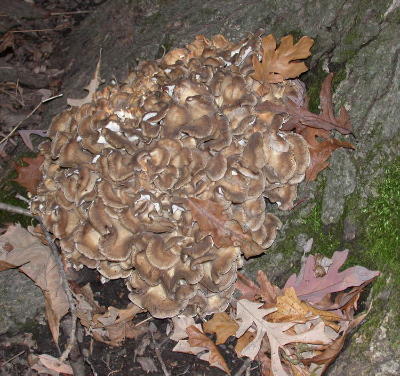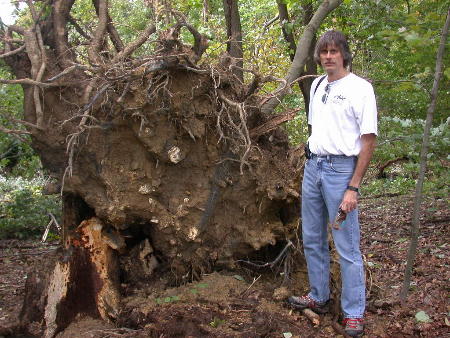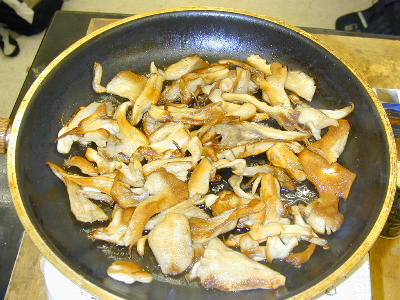Please click
TomVolkFungi.net for the rest of Tom Volk's pages on fungi
For a Thanksgiving treat, click here for "Fungal diseases that must be overcome to have a traditional Thanksgiving dinner."

This month's fungus is one of my favorite mushrooms for eating. Sometimes called the "hen of the woods" (not the chicken of the woods), it closely resembles the texture and meatiness of chicken breast when cooked properly. It also looks like a hen sitting on her nest in the woods-- at least if you have a vivid imagination. In certain parts of the country, especially western Pennsylvania and eastern Ohio, it is called "sheepshead," in reference to its resemblance to the wooly crown of a sheep that needs a haircut. In Japan, this mushroom is called "maitake," the dancing mushroom, because finders of this mushroom often dance for joy to celebrate their great find (I will admit to dancing for joy in the woods many times.). And a great find it is. It is not unusual to find specimens of 10 pounds (4kg) or more-- the largest I have ever found weighed in at 26 pounds (11.8 kg)! That's a feast to last a long time. My students and I found a lot of Grifola this year-- maybe over 150 pounds! Fortunately it preserves well by drying in a food dehydrator or just air drying, so we will be enjoying Grifola all winter. My favorite way to cook the hen is to slice off the "fronds" of the fruiting body and sauté them in olive oil and a little butter. I think that they are most delicious when substantially browned on the outside but still tender on the inside. however, they're also very good in stew, spaghetti sauce, and in stir fry. Yummy! You can also make a quasi-delicious tea out of the dried fruiting bodies by steeping a small piece in very hot water. Do not microwave the tea, because that is reported to destroy the active compounds, mostly the "D-fraction," reported to have medicinal properties (see below).
 Grifola can be found in the fall of the year in eastern North America, typically at the base of an oak tree. It doesn't grow directly from the trunk, but fruits off the living roots of the tree. Sometimes there may be several around one tree. An added bonus is that if you find Grifola around a particular tree, you can go back to that tree in subsequent years to find more. Of course you have to go at the right time of year, and the environmental conditions also have to be correct. You can usually go back to the same tree for 5-10 years or more to find additional fruiting bodies.
Grifola can be found in the fall of the year in eastern North America, typically at the base of an oak tree. It doesn't grow directly from the trunk, but fruits off the living roots of the tree. Sometimes there may be several around one tree. An added bonus is that if you find Grifola around a particular tree, you can go back to that tree in subsequent years to find more. Of course you have to go at the right time of year, and the environmental conditions also have to be correct. You can usually go back to the same tree for 5-10 years or more to find additional fruiting bodies.
However, there is a dark side to all this: Grifola is a parasite of the oak tree, getting its nutrients from the roots. Fortunately it is a "good" parasite, not killing its food source but keeping it alive as long as possible in order to maximize its own life. Unfortunately, most of the time the host tree eventually dies, probably from a combination of the Grifola infection and environmental stresses such as drought and wind. You can sometimes see a dead tree as a "tip up," where the tree has been blown down by the wind, broken off at the roots. At the right you can see my friend Jim Strutz with a blown-down tip-up of an oak tree in Pennsylvania. Jim had collected Grifola at the base of this tree for the previous 6-7 years.
 Grifola frondosa is also very popular in Korea, China and Japan, where it is cultivated as maitake, the dancing mushroom. Typically its mycelium is inoculated into plastic bags filled with supplemented sterilized sawdust or other wood-containing wastes. The mycelium is allowed to grow through the bag, a process that may take up to a couple months or more. At that time the sawdust has become annealed together to produce an artificial log. As the mycelium begins to run out of food, an opening is made in the bag (in this case the top), and fresh air is allowed to enter. This fresh air, with its increased concentration of oxygen and decreased concentration of carbon dioxide, is a signal to the mycelium that it is outside of the substrate and should form its fruiting body. It is a pretty efficient process, once the grower learns to provide the right conditions for growth and fruiting.
Grifola frondosa is also very popular in Korea, China and Japan, where it is cultivated as maitake, the dancing mushroom. Typically its mycelium is inoculated into plastic bags filled with supplemented sterilized sawdust or other wood-containing wastes. The mycelium is allowed to grow through the bag, a process that may take up to a couple months or more. At that time the sawdust has become annealed together to produce an artificial log. As the mycelium begins to run out of food, an opening is made in the bag (in this case the top), and fresh air is allowed to enter. This fresh air, with its increased concentration of oxygen and decreased concentration of carbon dioxide, is a signal to the mycelium that it is outside of the substrate and should form its fruiting body. It is a pretty efficient process, once the grower learns to provide the right conditions for growth and fruiting.
Other wood decay fungi can also be grown on artificial logs, including shiitake Lentinula edodes, oyster mushrooms (Pleurotus), and the lion's mane, (Hericium). Of these, Pleurotus and Hericium are by far the easiest to fruit reliably on sawdust; shiitake and maitake are a little trickier and need more attention. Some time I'll make shiitake the fungus of the month and describe in more detail how the artificial log thing works. I'm just waiting for the whole shiite-sunni thing to blow over...
 As alluded to earlier, maitake has been used in eastern Asian medicine for many millennia, reported to have a wide number of health benefits. Grifola frondosa is an apt example of a well-documented traditional Chinese medicine. The first record of its use comes from Shen Nong Ben Cao Jing (Shen Nong's Scripture of Herbal Medicine [cited in Mizuno and Zhuang 1995]), which was compiled between 200 BC and 200 AD. This scripture states that Keisho (one type of medicine made with Grifola frondosa) "has been used frequently for improving spleen and stomach ailments, calming nerves and mind, and treating hemorrhoids" (Mizuno and Zhuang 1995). There are a variety of other Chinese medicines containing Grifola frondosa, ranging from cancer treatment to remedies for palsy, nerve pain, and arthritis. Other described uses of this mushroom include general treatments for immune stimulation and regulation of homeostasis.
As alluded to earlier, maitake has been used in eastern Asian medicine for many millennia, reported to have a wide number of health benefits. Grifola frondosa is an apt example of a well-documented traditional Chinese medicine. The first record of its use comes from Shen Nong Ben Cao Jing (Shen Nong's Scripture of Herbal Medicine [cited in Mizuno and Zhuang 1995]), which was compiled between 200 BC and 200 AD. This scripture states that Keisho (one type of medicine made with Grifola frondosa) "has been used frequently for improving spleen and stomach ailments, calming nerves and mind, and treating hemorrhoids" (Mizuno and Zhuang 1995). There are a variety of other Chinese medicines containing Grifola frondosa, ranging from cancer treatment to remedies for palsy, nerve pain, and arthritis. Other described uses of this mushroom include general treatments for immune stimulation and regulation of homeostasis.
Controlled experiments have found many beneficial activities attributable to Grifola frondosa and/or its extracts. The most notable of these activities are the many reports of antitumor activity from Grifola. Certain extracts of this mushroom have been shown to inhibit carcinogenesis, metastasis, and tumor growth (Hishida et al. 1988). Nanba (1997) has studied Grifola as a treatment for cancer patients in Japan and found partial or complete remissions in most cases. While these studies and a great deal of anecdotal evidence for Grifola's use as an effective human cancer treatment can be cited, most studies have shown antitumor activities only in mice or using in vitro studies with cancer cell lines (Ohno et al. 1984, Hishida et al. 1988, Nanba 1995, Adachi et al. 1987). Although there are many studies using crude extracts of this mushroom, it should be noted that one of the most promising compounds is a mixture of complex branched polysaccharides called D-fraction (Nanba 1995, Nanba 1997). D-fraction is the hot-water-extractable, acid-insoluble, alkali-soluble fraction that has shown promise in cancer treatment.
 There have been numerous reports of other biological activities of this mushroom that could have therapeutic uses. These include immunomodulating properties, mostly through the action of inducing and attenuating cytokine production (including tumor necrosis factors) by macrophages (Suzuki et al. 1988, Adachi et al. 1994, Ohno 1995, Okazaki et al. 1995). This immunomodulation is likely due to interaction of the polysaccharides from Grifola with receptors on the cell surface of macrophages. Grifola has also been shown to have antihypertension and cholesterol-lowering effects (Kabir et al. 1987, Kabir and Kimura 1989, Adachi et al. 1988). Other studies have shown that extracts of Grifola can reduce the conversion of cultured cells to adipocytes (fat cells), which can result in reduction of weight gain in experimental animals (Nakai et al. 1999). Along these lines, various antidiabetic effects, such as reduction of blood glucose and modulation of insulin and triglyceride levels, have been demonstrated using extracts of Grifola (Kubo et al. 1994).
There have been numerous reports of other biological activities of this mushroom that could have therapeutic uses. These include immunomodulating properties, mostly through the action of inducing and attenuating cytokine production (including tumor necrosis factors) by macrophages (Suzuki et al. 1988, Adachi et al. 1994, Ohno 1995, Okazaki et al. 1995). This immunomodulation is likely due to interaction of the polysaccharides from Grifola with receptors on the cell surface of macrophages. Grifola has also been shown to have antihypertension and cholesterol-lowering effects (Kabir et al. 1987, Kabir and Kimura 1989, Adachi et al. 1988). Other studies have shown that extracts of Grifola can reduce the conversion of cultured cells to adipocytes (fat cells), which can result in reduction of weight gain in experimental animals (Nakai et al. 1999). Along these lines, various antidiabetic effects, such as reduction of blood glucose and modulation of insulin and triglyceride levels, have been demonstrated using extracts of Grifola (Kubo et al. 1994).
The most widely known Chinese medicinal mushrooms used are maitake (Grifola frondosa, described above), shiitake (Lentinula edodes, and reishi (Ganoderma lucidum). All of these mushrooms contain potent antitumor polysaccharides. These consist mostly of branched β-(1→ 3)-D-glucans. Many of these polysaccharides exist as a triple helix that is believed to interact with macrophages. The response of macrophages to β-(1→ 3)-D-glucans (including D-fraction from Grifola frondosa) has been shown to result from a β-glucan receptor on the cell surface. When fungal β-(1→ 3)-D-glucans bind this receptor, the macrophages increase release of lysosomal enzymes, active oxygen species, and cytokine (Borchers et al 1999).
I hope you enjoyed learning about Grifola frondosa, called by many other common names. If you're lucky enough to dance for joy in the woods upon finding this mushroom, I hope it helps you to enjoy a long and healthy life.
 This month's co-author is Nik Zitomer, who received his M.S. degree with me in 2003. As of this writing, Nik has defended his PhD thesis at Penn State and is working on the final revisions. Congratulations to (almost) Dr. Zitomer!
This month's co-author is Nik Zitomer, who received his M.S. degree with me in 2003. As of this writing, Nik has defended his PhD thesis at Penn State and is working on the final revisions. Congratulations to (almost) Dr. Zitomer!
If you have anything to add, or if you have corrections, comments, or recommendations for future FotM's (or maybe you'd like to be co-author of a FotM?), please write to me at 
This page and other pages are © Copyright 2006 by Thomas J.
Volk, University of Wisconsin-La Crosse.
Learn more about fungi! Go to Tom Volk's Fungi Home Page --TomVolkFungi.net
Return to Tom Volk's Fungus of the month pages listing


